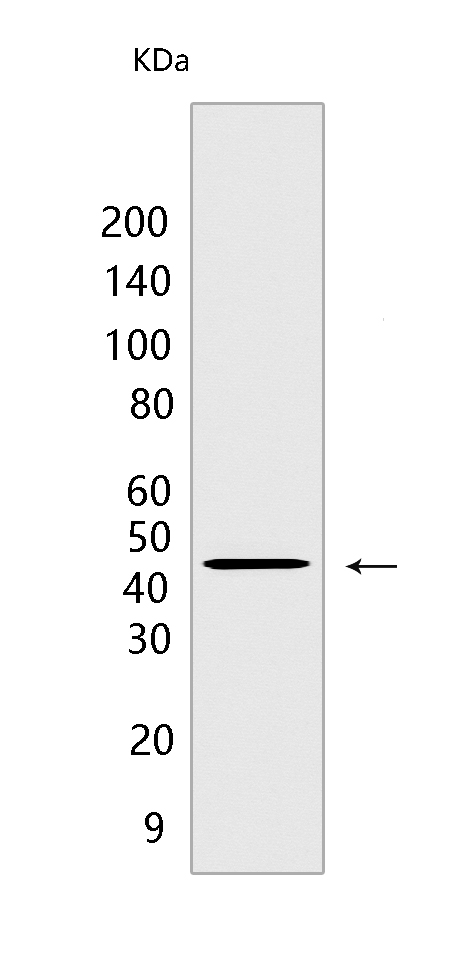Cystathionase/CTH Rabbit mAb [4H86]Cat NO.: A23966
Western blot(SDS PAGE) analysis of extracts from HeLa cells .Using Cystathionase/CTHRabbit mAb [4H86] at dilution of 1:1000 incubated at 4℃ over night.
Product information
Protein names :CTH,CGL_HUMAN,Cystathionine gamma-lyase
UniProtID :P32929
MASS(da) :44,508
MW(kDa) :44 kDa
Form :Liquid
Purification :Protein A purification
Host :Rabbit
Isotype :IgG
sensitivity :Endogenous
Reactivity :Human
- ApplicationDilution
- 免疫印迹(WB)1:1000-2000
- The optimal dilutions should be determined by the end user
Specificity :Antibody is produced by immunizing animals with a synthetic peptide at the sequence of human Cystathionase/CTH
Storage :Antibody store in 10 mM PBS, 0.5mg/ml BSA, 50% glycerol. Shipped at 4°C. Store at-20°C or -80°C. Products are valid for one natural year of receipt.Avoid repeated freeze / thaw cycles.
WB Positive detected :HeLa cells
Function : Catalyzes the last step in the trans-sulfuration pathway from L-methionine to L-cysteine in a pyridoxal-5'-phosphate (PLP)-dependent manner, which consists on cleaving the L,L-cystathionine molecule into L-cysteine, ammonia and 2-oxobutanoate (PubMed:10212249, PubMed:19261609, PubMed:19961860, PubMed:18476726). Part of the L-cysteine derived from the trans-sulfuration pathway is utilized for biosynthesis of the ubiquitous antioxidant glutathione (PubMed:18476726). Besides its role in the conversion of L-cystathionine into L-cysteine, it utilizes L-cysteine and L-homocysteine as substrates (at much lower rates than L,L-cystathionine) to produce the endogenous gaseous signaling molecule hydrogen sulfide (H2S) (PubMed:10212249, PubMed:19261609, PubMed:19961860, PubMed:19019829). In vitro, it converts two L-cysteine molecules into lanthionine and H2S, also two L-homocysteine molecules to homolanthionine and H2S, which can be particularly relevant under conditions of severe hyperhomocysteinemia (which is a risk factor for cardiovascular disease, diabetes, and Alzheimer's disease) (PubMed:19261609). Lanthionine and homolanthionine are structural homologs of L,L-cystathionine that differ by the absence or presence of an extra methylene group, respectively (PubMed:19261609). Acts as a cysteine-protein sulfhydrase by mediating sulfhydration of target proteins: sulfhydration consists of converting -SH groups into -SSH on specific cysteine residues of target proteins such as GAPDH, PTPN1 and NF-kappa-B subunit RELA, thereby regulating their function (PubMed:22169477). By generating the gasotransmitter H2S, it participates in a number of physiological processes such as vasodilation, bone protection, and inflammation (Probable) (PubMed:29254196). Plays an essential role in myogenesis by contributing to the biogenesis of H2S in skeletal muscle tissue (By similarity). Can also accept homoserine as substrate (By similarity). Catalyzes the elimination of selenocystathionine (which can be derived from the diet) to yield selenocysteine, ammonia and 2-oxobutanoate (By similarity)..
Tissue specificity :Highly expressed in liver (PubMed:10727430, PubMed:20305127). Also in muscle and lower expression in most tissues except heart, pituitary gland, spleen, thymus, and vascular tissue, where it is hardly detected (PubMed:20305127)..
Subcellular locationi :Cytoplasm.
IMPORTANT: For western blots, incubate membrane with diluted primary antibody in 1% w/v BSA, 1X TBST at 4°C overnight.


